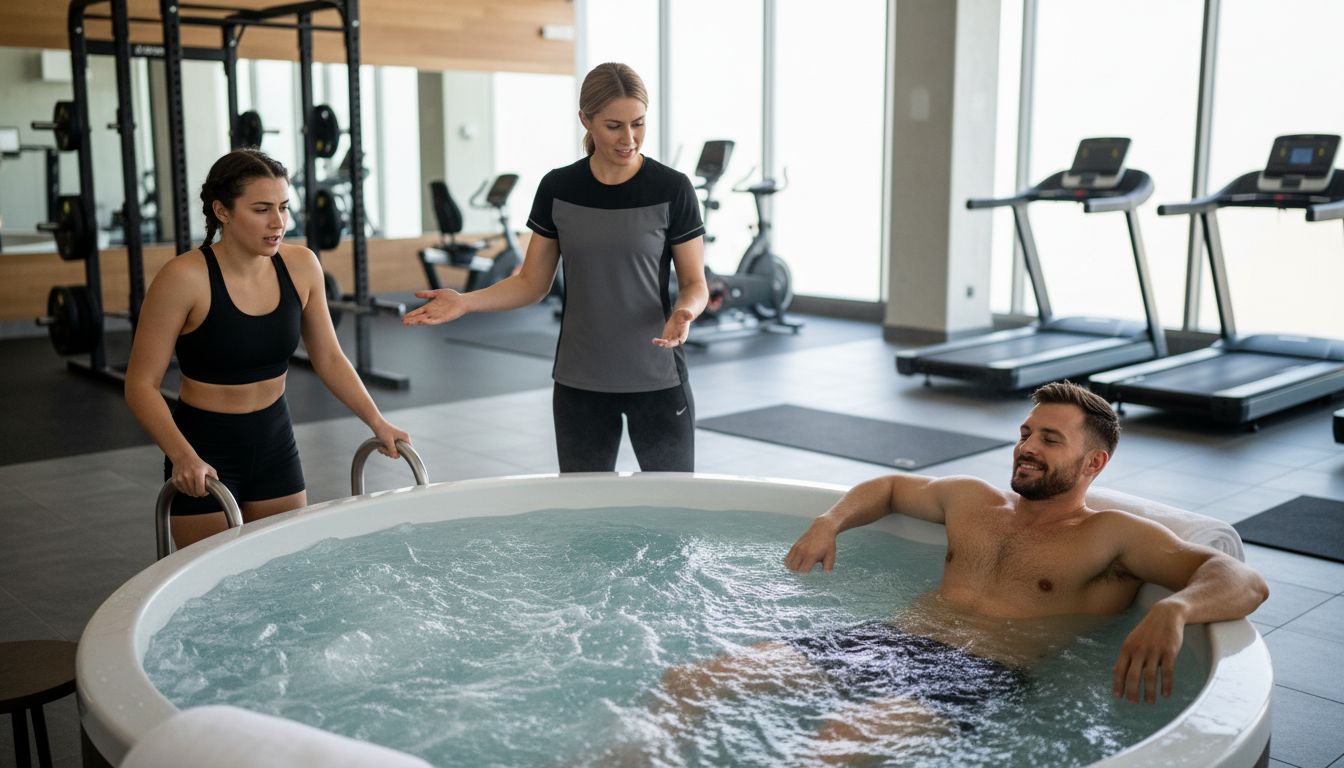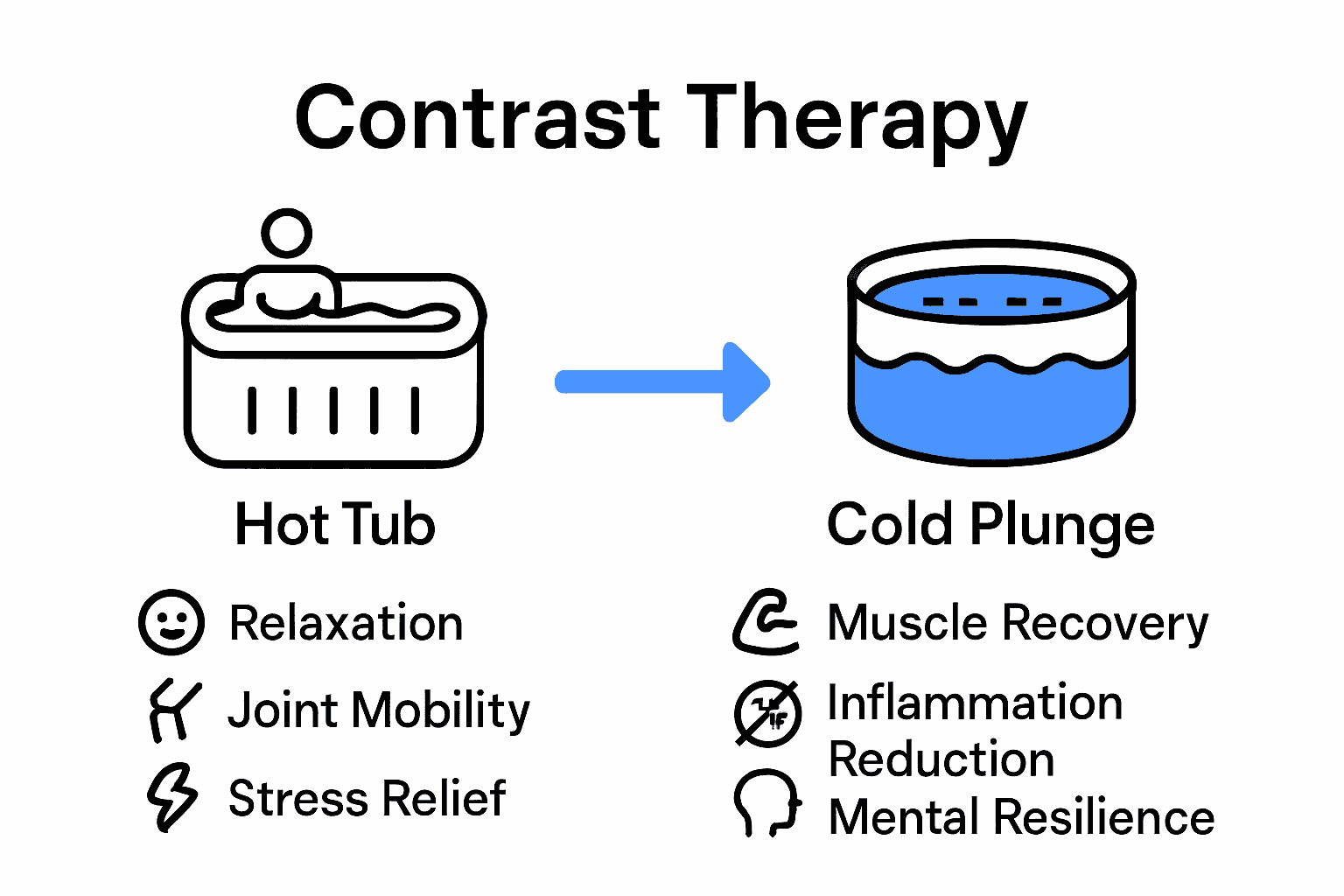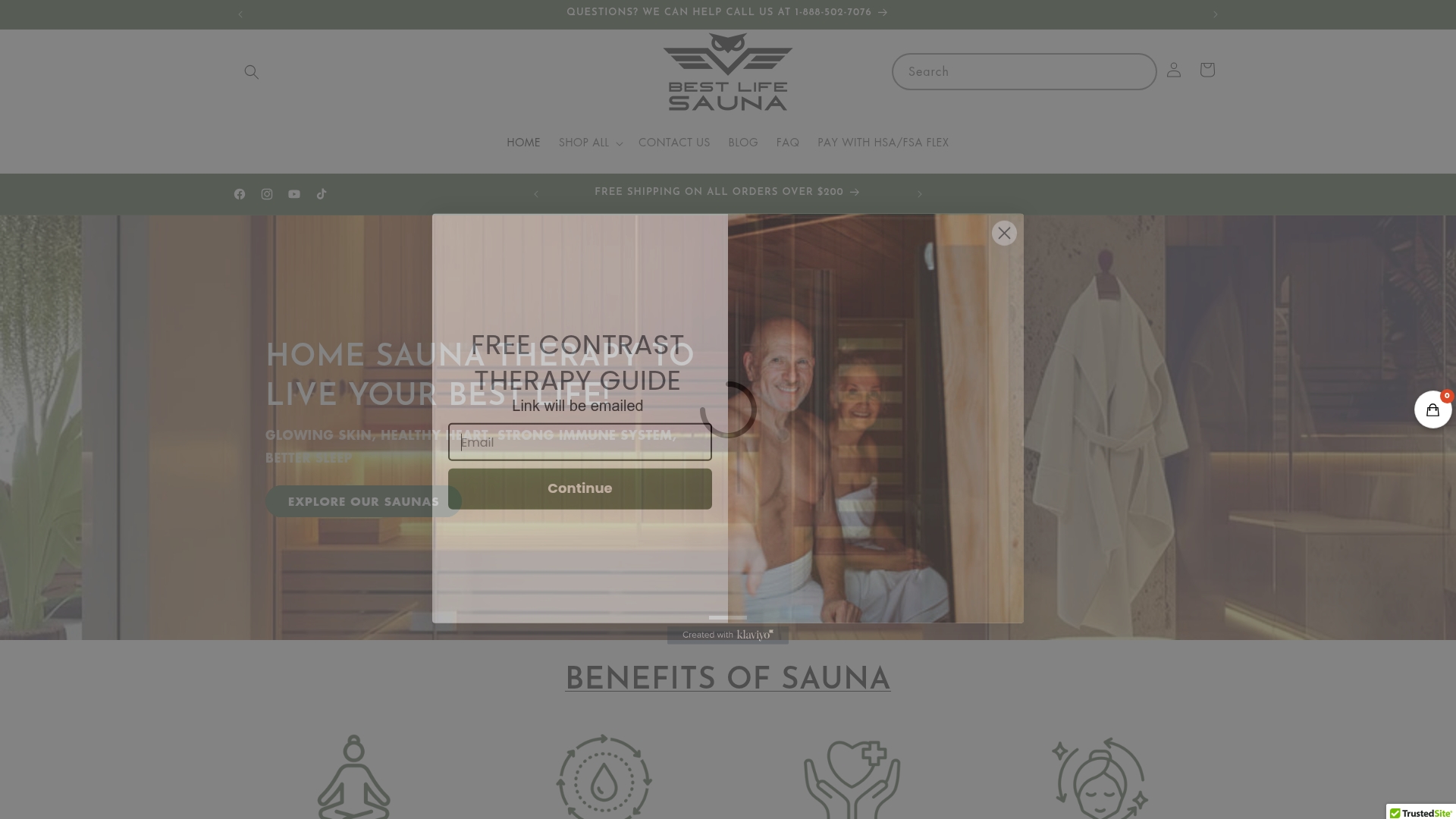
Hot Tub vs Cold Plunge: Complete Comparison Guide
Nearly 60 percent of wellness enthusiasts now experiment with both hot tubs and cold plunges at home, exploring the contrast between intense heat and chilling cold for better health. These two therapies might seem worlds apart, yet together they unlock benefits many people never expect. Whether you are chasing deeper relaxation, faster recovery, or stronger resilience, understanding how each approach works can help you tailor your wellness journey for maximum results.
Table of Contents
- Hot Tubs And Cold Plunges Defined Clearly
- Key Health Benefits And Wellness Effects
- Physical And Psychological Mechanisms Explained
- Optimal Usage, Safety, And Maintenance Tips
- Comparing Costs, Installation, And Longevity
- How To Choose The Right Solution
Key Takeaways
| Point | Details |
|---|---|
| Complementary Practices | Hot tubs provide relaxation and stress relief, while cold plunges focus on muscle recovery and inflammation reduction. These approaches can be integrated for enhanced wellness benefits. |
| Health Benefits | Hot water therapy improves circulation and reduces stress, whereas cold water immersion enhances recovery and boosts mental resilience. Both promote unique physiological responses that aid overall health. |
| Safety Considerations | Beginners should gradually increase exposure times to cold plunges and limit hot tub sessions to avoid potential health risks. Proper temperature and hydration are crucial for safe usage. |
| Cost and Longevity | Cold plunges are generally more affordable and require less installation complexity compared to hot tubs, which have higher upfront costs but offer relaxation benefits over their lifespan. |
Hot Tubs and Cold Plunges Defined Clearly
When it comes to wellness and recovery practices, hot tubs and cold plunges represent two dramatically different yet complementary approaches to body therapy. According to Wikipedia, a hot tub is a large tub filled with heated water designed for hydrotherapy, relaxation, and pleasure, often featuring massage jets and accommodating multiple people simultaneously.
In contrast, a cold plunge or ice bath is an entirely different experience. Wikipedia defines cold-water immersion as the practice of immersing a substantial body part in ice or ice-water for a limited duration. Athletes and fitness enthusiasts frequently use this technique for post-exercise recovery, helping reduce muscle inflammation and accelerate healing processes.
Key Characteristics
Hot tubs and cold plunges differ significantly in their core characteristics:
-
Hot Tubs:
- Heated water (typically 100-104°F)
- Designed for relaxation and social interaction
- Often feature hydrotherapy jets
- Can accommodate multiple people
- Excellent for muscle relaxation and stress relief
-
Cold Plunges:
- Extremely cold water (typically 50-59°F)
- Used primarily for physical recovery
- Short immersion periods (2-5 minutes)
- Individual use
- Targets muscle recovery and reduces inflammation
While seemingly opposite, these wellness practices actually complement each other beautifully. Many health enthusiasts are now incorporating both hot tubs and cold plunges into their wellness routines, leveraging the unique benefits of temperature contrast therapy.
 The transition between heated relaxation and cold-induced recovery can stimulate circulation, boost metabolism, and enhance overall physical resilience.
The transition between heated relaxation and cold-induced recovery can stimulate circulation, boost metabolism, and enhance overall physical resilience.
Key Health Benefits and Wellness Effects
Temperature therapy through hot tubs and cold plunges represents a powerful approach to holistic wellness. According to WebMD, cold plunges can soothe muscles after workouts, boost mood, and provide significant health benefits - though individuals are advised to consult their healthcare provider before starting any new therapy.
Hot tubs and cold plunges offer unique physiological responses that can dramatically impact overall health. Hot water immersion triggers vasodilation, increasing blood circulation and helping muscles relax. This process can reduce stress, lower blood pressure, and potentially improve cardiovascular function. Conversely, cold water immersion stimulates the body’s natural healing mechanisms through a process called hormesis - where controlled stress triggers positive adaptive responses.
Specific Health Benefits
Each temperature therapy provides distinct wellness advantages:
-
Hot Tub Benefits:
- Reduces muscle tension
- Improves sleep quality
- Decreases stress hormones
- Enhances joint mobility
- Promotes deep relaxation
-
Cold Plunge Benefits:
- Reduces muscle inflammation
- Accelerates post-exercise recovery
- Boosts immune system function
- Increases mental resilience
- Potentially improves metabolic health
The most advanced wellness strategies now incorporate contrast therapy - alternating between hot and cold environments. This technique can create a powerful physiological reset, stimulating circulation, enhancing immune response, and potentially triggering deeper healing mechanisms. By understanding and strategically using temperature variations, individuals can unlock remarkable potential for physical and mental wellness.

Physical and Psychological Mechanisms Explained
Understanding the body’s response to temperature extremes reveals a fascinating interplay of physiological and psychological mechanisms. Thermal stress triggers complex bodily reactions that go far beyond simple temperature changes. According to WebMD, during a cold plunge, the body initiates a protective response by constricting blood vessels to slow blood flow and limit heat loss, which can temporarily elevate heart rate, blood pressure, and breathing rate.
The neurological response to temperature therapy is equally intricate. When exposed to extreme temperatures, the body activates the sympathetic nervous system - our fight-or-flight mechanism. In hot tubs, this manifests as deep relaxation, with heat causing blood vessels to dilate and muscles to release tension. Cold plunges, conversely, trigger a more intense neurological response, creating a controlled stress environment that challenges the body’s adaptive capabilities.
Physiological Response Mechanisms
Key physiological mechanisms during temperature therapy include:
-
Cardiovascular Adaptations:
- Blood vessel constriction and dilation
- Increased heart rate variability
- Enhanced circulatory efficiency
- Improved cardiovascular flexibility
-
Neurochemical Changes:
- Release of endorphins
- Reduction of stress hormones
- Activation of thermal shock proteins
- Stimulation of neural plasticity
Psychologically, these temperature experiences create a powerful mind-body connection. The controlled stress of alternating between hot and cold environments trains the nervous system to become more resilient. This process, known as hormetic conditioning, helps individuals develop greater mental toughness, emotional regulation, and physiological adaptability. By deliberately exposing the body to these controlled stressors, people can potentially enhance their overall stress management capabilities and improve both mental and physical performance.
Optimal Usage, Safety, and Maintenance Tips
Navigating the world of hot tubs and cold plunges requires careful attention to safety and proper technique. WebMD recommends that beginners start with short cold plunges, beginning with just 30 seconds to a minute and gradually working up to 5-10 minutes. It’s crucial to avoid prolonged exposure, as staying in cold water for more than 30 minutes can risk hypothermia.
Temperature management is critical for both hot tubs and cold plunges. According to Wikipedia, the U.S. Consumer Product Safety Commission provides specific guidelines for hot tub temperatures. Healthy adults should maintain water temperatures around 98.6°F (37°C), with an absolute maximum of 104°F (40°C). Special care is needed for pregnant individuals, as water temperatures above 102.2°F (39°C) can potentially cause fetal damage during the first three months of pregnancy.
Usage and Safety Guidelines
Key considerations for safe and effective temperature therapy include:
-
Cold Plunge Precautions:
- Start with very short duration (30-60 seconds)
- Gradually increase exposure time
- Listen to your body
- Have a warm towel and dry clothes ready
- Never plunge alone
-
Hot Tub Safety Measures:
- Limit sessions to 15-20 minutes
- Stay hydrated
- Avoid alcohol before or during use
- Check water temperature regularly
- Maintain proper chemical balance
Maintenance is equally crucial for both hot tubs and cold plunge setups. Regular cleaning, water testing, and equipment checks prevent potential health risks and ensure optimal performance. For hot tubs, this means monitoring chemical levels, cleaning filters, and checking heating elements. Cold plunge tubs require frequent water changes and thorough sanitization to prevent bacterial growth. Always consult with healthcare professionals if you have pre-existing medical conditions or are unsure about your ability to safely engage in temperature therapy.
Comparing Costs, Installation, and Longevity
Understanding the financial and practical implications of hot tubs and cold plunges is crucial for potential buyers. Strength Warehouse USA highlights significant differences in cost, installation complexity, and long-term maintenance between these two wellness investments. Cold plunges generally offer a more budget-friendly and straightforward solution, requiring minimal space and infrastructure compared to their more complex hot tub counterparts.
The initial investment varies dramatically between hot tubs and cold plunges. Hot tubs typically represent a more substantial financial commitment, with prices ranging from $5,000 to $20,000, depending on size, features, and quality. Cold plunges, by contrast, can be more economical, with options ranging from $2,000 to $10,000. Installation costs further differentiate these options - hot tubs often require professional electrical work, dedicated structural support, and potentially landscaping modifications, while cold plunges can frequently be set up with minimal professional intervention.
Cost and Installation Breakdown
Key comparative factors include:
-
Cold Plunge Advantages:
- Lower initial purchase cost
- Minimal installation requirements
- Smaller physical footprint
- Reduced ongoing maintenance expenses
- Faster setup time
-
Hot Tub Considerations:
- Higher upfront investment
- Complex electrical and structural preparations
- Significant ongoing maintenance costs
- Regular chemical and filter expenses
- Potential increased home insurance premiums
Longevity is another critical factor in this comparison. Well-maintained hot tubs typically last 10-15 years with proper care, while high-quality cold plunge units can potentially exceed 20 years with minimal maintenance. Factors like material quality, frequency of use, and environmental conditions play significant roles in determining the actual lifespan of these wellness investments. Potential buyers should carefully consider their long-term wellness goals, available space, budget constraints, and maintenance capabilities when selecting between a hot tub and a cold plunge.
How to Choose the Right Solution
Selecting between a hot tub and a cold plunge is a nuanced decision that requires careful consideration of personal wellness goals and practical constraints. Strength Warehouse USA highlights that the choice fundamentally depends on individual wellness objectives, budget, and available space. Cold plunges excel for those seeking muscle recovery and mental resilience, while hot tubs are better suited for relaxation and stress relief.
The decision-making process involves evaluating several critical factors. Physical fitness level, specific health goals, recovery needs, and personal comfort with temperature extremes play significant roles. Athletes and fitness enthusiasts might gravitate towards cold plunges for their proven muscle recovery benefits, whereas individuals seeking stress reduction and social relaxation might prefer the more comfortable environment of a hot tub. Personal medical history, age, and current physical condition are also crucial considerations that can dramatically influence the most appropriate choice.
Selection Criteria Checklist
Key considerations for making your decision include:
-
Choose Cold Plunge If You:
- Are focused on athletic recovery
- Enjoy challenging physical experiences
- Want to boost mental toughness
- Prioritize inflammation reduction
- Have limited installation space
-
Choose Hot Tub If You:
- Seek relaxation and stress relief
- Enjoy social wellness experiences
- Want muscle tension reduction
- Prefer consistent comfort
- Have space for larger installation
Ultimately, the most effective wellness solution might involve incorporating both modalities into your routine. Contrast therapy - alternating between hot and cold treatments - represents a cutting-edge approach to holistic wellness. Some enthusiasts invest in portable or smaller versions of both options, allowing maximum flexibility. Consulting with healthcare professionals, understanding your personal wellness goals, and carefully assessing your physical space and budget will guide you toward the most appropriate temperature therapy solution.
Unlock the Power of Temperature Therapy With Best Life Sauna
Choosing between a hot tub and a cold plunge can feel overwhelming when you want the best for your recovery and relaxation. The article highlights the challenge of balancing muscle recovery, stress relief, and wellness goals while considering safety, budget, and lifestyle. Many people desire the benefits of temperature contrast therapy but need a trusted source for quality products that fit their space and needs.
At Best Life Sauna, we understand your journey toward enhanced physical and mental health through cutting-edge wellness solutions. Whether you want to soothe muscle inflammation with a cold plunge or melt away stress in a hot tub, our carefully selected range supports your goals with premium options that offer durability, safety, and comfort. Discover how integrating sauna products alongside hot tubs and cold plunge tubs can create a complete home spa ecosystem tailored for your optimal health.
Experience the difference today with Best Life Sauna, where we prioritize your wellness with expert guidance, competitive pricing, and customer satisfaction.
Elevate your recovery and relaxation routine with confidence.
Experience the best in wellbeing with our curated selection of hot tubs, cold plunge tubs, and rejuvenating saunas.
Explore our collection and start transforming your health now.

Frequently Asked Questions
What are the main differences between hot tubs and cold plunges?
Hot tubs use heated water for relaxation and stress relief, typically at temperatures of 100-104°F, while cold plunges involve immersion in extremely cold water (50-59°F) primarily for recovery and to reduce inflammation.
What are the health benefits of using a hot tub?
Hot tubs can help reduce muscle tension, improve sleep quality, decrease stress hormones, enhance joint mobility, and promote deep relaxation through vasodilation and increased blood circulation.
How long should I stay in a cold plunge?
Beginners should start with cold plunges for a short duration of 30 seconds to 1 minute and can gradually increase to 5-10 minutes, depending on personal comfort and body response.
Can I use both hot tubs and cold plunges in my wellness routine?
Yes, incorporating both hot tubs and cold plunges into a wellness routine is beneficial. This contrast therapy can stimulate circulation, enhance recovery, and promote overall physical and mental resilience.

